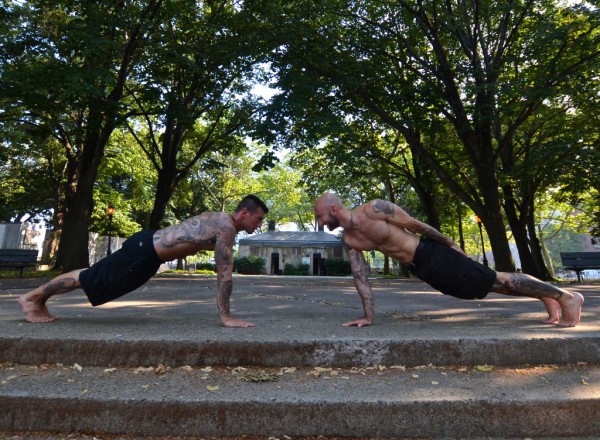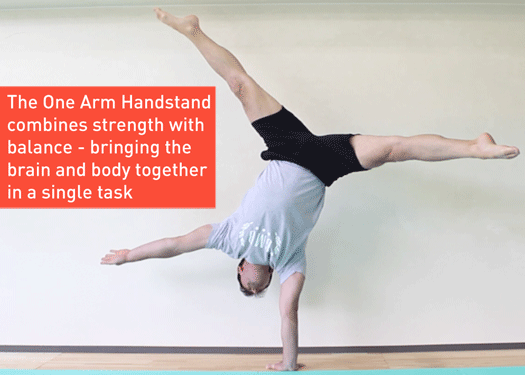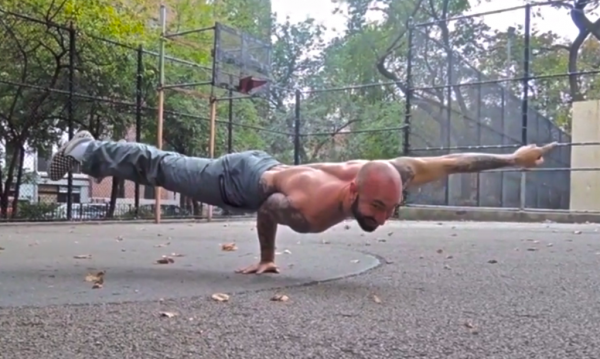It’s an exciting time in the world of strength and fitness. We’re seeing a lot of converts from weight training to the types of bodyweight exercise taught in Progressive Calisthenics.
Many of these “converts” find themselves humbled and surprised by the incredible challenge presented by bodyweight exercise, even after spending years developing strength and skill with barbells, dumbbells, and the like. As they continue to practice and improve, they find strength that wasn’t there when they trained with regular weight lifting exercise.
So what is it about progressive calisthenics that is so different and unique from weight training?
One of the big benefits of this type of training is how stimulating it is to the nervous system. The simple act of moving your body through space, as opposed to moving an implement, switches on the connections between your brain and body.
At the risk of sounding trite, it really is a “natural” and innate process to take your body and hang, swing, climb, pull, and jump through the air. Movement since we could walk upright has been meant to get us somewhere, and moving our whole body – not just parts of it – is what we were born to do.
Of couse, I’m preaching to the choir here, but by understanding how the exercise movements in Progressive Calisthenics stimulate the brain, we can learn to leverage that connection for greater strength and skill development.
Movement, Muscle Memory, and the Mind-Body Connection
As noted above, much of the “secret sauce” comes from movement.
When performing progressive calisthenic type exercises, from pushups to pistols, and from rings to monkey bars, the majority of the time we’re moving our head around in space, which we’re not used to doing with barbells and machine exercises.
I teach both children’s and adult classes and I see how a lot of people who come from a weight lifting background have trouble when they first start up at our gym. They get dizzy and disoriented quickly when doing certain movements while the kids don’t seem to have any of the same issues. Maybe it’s because kids get to roll around, swing on the monkey bars and do normal “kid stuff”, while the adults are stuck in their offices most of the day and then work out on machines a few times a week.
This increased head movement lends an incredible amount of sensory information – the visual position changes, vestibular (inner ear) stimulation, and even the sensations on the skin from the air we’re cutting through.
All of these compound to stimulate our brain and the connections between it and every part of our bodies.
So-called muscle and body “memory” is actually the result of the repeated body motions strengthening the neural pathways used in those particular skills. With repeated practice, we grease the groove, and bodyweight movements tend to be learned in a faster and more stable manner because of all those sensory inputs. It’s actually easier for the body to “remember” these moves as opposed to the dull and forgettable lifting exercises.
The catchphrase “movements, not muscles” refers to training full body patterns versus isolating body parts to build up certain muscles. In a whole body move such as a one arm pushup, it’s the coordinated engagement of all of your muscles that creates a successful repetition. You’re not working on your chest or triceps alone; your whole body works together to perform the exercise.
This full body connection is key to athletic performance and will improve your ability in your chosen sport.
4 Bodyweight Exercises that Blow Their Weighted Counterparts Out of the Water
There are many examples of bodyweight exercises that better utilize this neurological connection than their weighted counterparts.
Below, I’ll highlight how four such exercises leverage increased stimulation to recruit the entire body in tasks that might otherwise isolate just a few muscle groups.
1. Pull-up vs. Pulldown
A prime example of the difference between a bodyweight movement vs. a weighted movement is the bodyweight pull-up compared to a pulldown. There is the obvious difference of moving your whole body in a pull-up, but there are also a few other key differences that make pull-ups so much better than a pulling on a cable.
First, aside from the infamous kipping pull-ups, it’s much more difficult to cheat on a pull-up. Pulldowns by their very nature encourage cheats like laying back or heaving on the handle when you get fatigued. Similarly, it’s easier to rest a bit using a machine, since you can wiggle and shift a little, whereas in a pull-up, you’ll need to concentrate and dial in your form even more when you are tired. And of course, the whole body “tightness” that you need to perform a good pull-up can’t really be done on any machine.
2. Jumping vs. Any “Cardio” Machine
You’ve likely been in a gym and seen people chugging away on treadmills, stairsteppers, and bikes going nowhere, and you just know deep down there isn’t much that would be more boring for the mind and spirit. That’s why you see so many people on them with earbuds on or staring at the TV!
Jumping exercises are the polar opposite of these machines. Propelling our bodies up for distance or height while landing accurately and safely requires our full attention and concentration. And there’s nothing better for getting the heart rate going than fast and powerful jumping.
Of course, everybody thinks they know how to jump, and in this case, nearly everybody is wrong…
By learning to jump with correct form and developing precise control over our technique, the jump takes on whole new levels of neurological stimulation that go far beyond simple power output.
I’m sure I don’t have to tell you what an awesome exercise the pistol squat is. It builds strength, flexibility, and balance like nothing else. But what sets it apart from weighted squats – of which there are many variations – is the difficulty with cheating and breaking form.
When performing weighted squats, breaks in technique can sneak up on you without you noticing. When the weight gets piled on and you’re cranking out the last reps, it’s fairly easy to lean forward, let your knees buckle, and raise your butt first when standing up. With the pistol, on the other hand, doing any of those things could throw off your balance, so you’re more likely to maintain a safe and stable line. Of course, there are many ways people cheat when it comes to the pistol, but it is harder to do so than with the barbell squat.
As with other exercises mentioned, one of the benefits of the pistol is the lack of a heavy load on the back. Since back issues can be a problem for so many people, heavy barbell squats can be bad idea until the back is properly rehabilitated.
4. Inverted Bodyweight Row vs. Barbell Row
One of the most important advantages of the inverted bodyweight row over the barbell row is safety. To perform the barbell row safely, without risk of injury, you need to have good form and an already strong and stable low back. If you practice barbell rows without an already stable core, you could hurt your back pretty badly. Add in trying to hold good form when you get fatigued and you’ll be skirting the edge of a cliff.
With the inverted bodyweight row, that particular issue doesn’t exist. So if you have any back issues to begin with, bodyweight rows are the way to go. Don’t be fooled, though. The bodyweight row will still work pretty much the entire body, and will probably help you to improve your core stabilization.
Of course, this list could go on, but I think you get the idea.
Stimulate Your Body, Stimulate Your Brain
The exercises listed above are just a few examples of the advantages of training with bodyweight movements over training primarily with weights. There are some general benefits, though, that should be reiterated.
When you move your body through space, rather than staying still and moving weight around your body, you stimulate your brain through providing increased proprioceptive input. What this means is building a sense of where your body is in space.
Proprioception is what allows you to bend your elbow or flex your foot a precise amount or in a precise way, even if your eyes are closed and you can’t see what you’re doing – you still feel it.
Once upon a time, it may not have been as important to specifically address proprioception, but today, we spend most of our time sitting still. As a result we spend less of our time engaged in activities that increase proprioceptive input naturally, such as running, climbing, and just generally moving the body. To combat the perils of prolonged sitting, it’s important to engage the body in coordinated movements that increase the proprioception that would otherwise be neglected.
An additional benefit of most bodyweight exercises, including all of the exercises listed above, is the required full body coordination and tightness.
For instance, when you do a pull-up, if any part of your body is loose, you’ll leak power through the loose parts and wind up fatiguing quicker and not getting the full benefit of the exercise. Continued practice in maintaining this full body tightness and form carries over to a lot of athletic endeavors, because it strengthens the neural pathways that are devoted to the control of those muscles.
Moving yourself around in unusual angles and with harder leverages creates strength and flexibility in the best way possible. You learn to have powerful and graceful control of your body in a lot of different situations.
It’s also important to approach training with a sense of fun and excitement in developing your strength and flexibility. Exploring how your body moves and experimenting with different movements helps you to look at your strength in a whole new way.
As I mentioned earlier, I teach both kids and adults and it’s great to see adults moving with the same freedom and abandon as their kids. I love teaching exploratory bodyweight exercise and even more, I love how it’s gotten folks to enjoy and have fun with their training again.
Here’s some examples you might add to your routine:
Though this mind-body communication is baked right into Progressive Calisthenics, there are a couple of things you can do to be sure you are getting the most out of the work you put in:
- Pay attention to your movement in space. This increases proprioception and develops coordination.
- Take a note from Al Kavadlo and remember to smile. Have fun with the movements and enjoy exploring new skills and learning as you go along.
The benefits of bodyweight exercise are endless, as anybody involved with the PCC method knows. It’s a good idea, though, to understand the details behind why you’re feeling much better from this type of exercise performance. You can then adjust your technique and your exercises as needed to improve even more.
***
In former lives, Ryan Hurst has been a gymnast, a swordsman, and a yoga teacher. Now he teaches an integrated approach to strength and movement skill at http://gmb.io/



